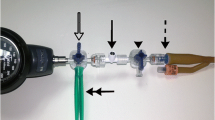Abstract
Pneumatic reduction using air has recently become popular for the initial non-surgical managment of intussusception. Since carbon dioxide (CO2) is rapidly absorbed from body surfaces, it should theoretically result in less cramping and distension following reduction. We reviewed our recent experience with the pneumatic reduction of intussusception using CO2 in 26 children. In 22 of these the intussusception was reduced (85%). There was one perforation with CO2; the patient did not suffer any postoperative complications. Five additional children who had been treated unsuccessfully with barium had intussusception subsequently reduced with CO2. Following CO2 reduction, most children were fed within hours, and there were no instances of significant abdominal distension or cramping. We conclude that pneumatic reduction of intussusception using CO2 is safe and effective, and has the theoretical advantage of more rapid absorption from the gastrointestinal tract than air.
Similar content being viewed by others
References
Schmitz-Rode T, Muller-Liesse C, Alzen G (1991) Comparative examination of various rectal tubes and contrast media for the reduction of intussusceptions. Pediatr Radiol 21:341–345
Shiels WE, Maves CK, Hedlund GL, Kirks DR (1991) Air enema for diagnosis and reduction of intussusception: clinical experience and pressure correlates. Radiology 181:169–172
Sargent MA, Wilson BPM (1991) Are hydrostatic and pneumatic methods of intussusception reduction comparable? Pediatr Radiol 21:346–349
Stringer DA, Ein SH (1990) Pneumatic reduction: advantages, risks and indications. Pediatr Radiol 20:475–477
Palder SB, Eion SH, Stringer DA, Alton D (1991) Intussusception: barium or air? J Pediatr Surg 26:271–275
Bernier P, Coblentz C (1986) CO2 delivery system for double-contrast barium enema examinations. Radiology 159:264
Hedlund GL, Johnson JF, STrife JL (1990) Ileocolic intussusception: extensive reflux of air preceding pneumatic reduction. Radiology 174:187–189
Todani T, Sato Y, Watanabe Y, et al (1990) Air reduction for intussusception in infancy and childhood: ultrasonographic diagnosis and management without X-ray exposure. Z Kinderchir 45:222–226
Gu L, Alton D, Daneman A, et al (1988) Intussusception reduction by rectal insufflation of air. AJR 150:1345–1348
Guo J, Ma X, Shou Q (1986) Results of air pressure enema reduction of intussusception: 6396 cases in 13 years. J Pediatr Surg 21:1201–1203
Jinzhe Z, Yenxia W, Linchi W (1986) Rectal inflation reduction of intussusception in infants. J Pediatr Surg 21:30–32
Gierup J, Jorulf H, Livaditis A (1972) Management of intussusception in infants and children: a survey based on 288 consecutive cases. Pediatrics 50:535–541
Ching E, Ching LT, Lynn HB, et al (1990) Intussusception in children. Mayo Clin Proc 45:724–728
Author information
Authors and Affiliations
Rights and permissions
About this article
Cite this article
Paterson, C.A., Langer, J.C., Somers, S. et al. Pneumatic reduction of intussusception using carbon dioxide. Pediatr Radiol 24, 296–297 (1994). https://doi.org/10.1007/BF02015463
Received:
Accepted:
Issue Date:
DOI: https://doi.org/10.1007/BF02015463




